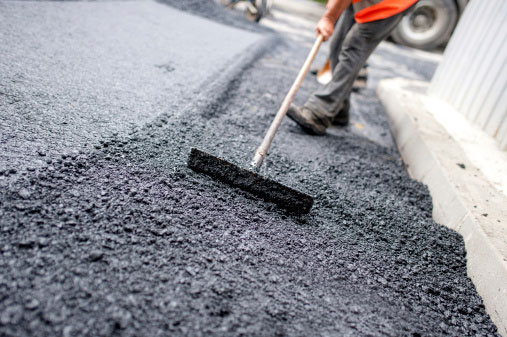Warm Mix Asphalt: A Lasting Solution for Sidewalk
Hot Mix Asphalt (HMA) has actually arised as a leading sustainable selection for pavement remedies, using a myriad of ecological advantages and ingenious innovations. As the need for environment-friendly construction techniques expands, discovering the nuances of HMA's sustainability can give important understandings into the future of sidewalk services.
Ecological Benefits of Hot Mix Asphalt

In Addition, Warm Mix Asphalt helps to alleviate urban warm island effects. Its dark shade takes in sunshine, minimizing the quantity of heat mirrored back into the ambience compared to lighter-colored pavements. This can decrease ambient temperature levels in metropolitan areas, reducing the need for air conditioning and eventually minimizing power intake.
Additionally, Hot Mix Asphalt adds to boosted stormwater monitoring. Its permeable nature allows water to reenergize and penetrate the sidewalk groundwater products, lowering runoff and the risk of flooding. These ecological advantages make Hot Mix Asphalt a lasting selection for leading roadways and freeways.
Energy Effectiveness in HMA Production
Is power effectiveness a crucial variable in the production of Hot Mix Asphalt (HMA)? Power plays a substantial duty in the manufacturing of HMA, impacting both price and environmental sustainability. One essential aspect of power performance in HMA manufacturing is the use of cozy mix asphalt (WMA) modern technologies.
Moreover, developments in plant technologies have actually brought about even more energy-efficient HMA production procedures. Modern plants are developed with features like recycled asphalt sidewalk (RAP) handling abilities, reliable burner systems, and improved insulation, all contributing to energy savings. By enhancing power usage in HMA manufacturing, the industry can reduce its carbon impact while maintaining high-grade sidewalk products. Energy effectiveness is, therefore, a crucial factor to consider in guaranteeing the sustainability of Hot Mix Asphalt manufacturing.
Recyclability of Hot Mix Asphalt
The recyclability of Hot Mix Asphalt (HMA) is a crucial aspect of its sustainability and lasting environmental effect. HMA is just one of one of the most recycled materials in the United States, with over 100 million lots of redeemed asphalt sidewalk (RAP) being reused yearly in new sidewalk building and construction. Recycling HMA uses numerous ecological advantages, such as minimizing the need for virgin materials, reducing energy usage during manufacturing, and lowering the quantity of waste sent out to land fills.
The procedure of reusing HMA involves milling the existing pavement, crushing it into smaller pieces, and mixing it with brand-new aggregate and asphalt binder to produce a recycled mix. Generally, the recyclability of HMA plays a considerable role in promoting sustainable techniques within the sidewalk market.

Long-Term Performance of HMA
Asphalt pavements demonstrate resilience and strength over a prolonged period, showing the lasting efficiency of Warm Mix Asphalt (HMA) The durability of HMA can be credited to its capability to hold up against rush hour lots, extreme weather, and the impacts of aging. Research studies have shown that well-designed and correctly constructed HMA pavements can last for two decades or even more with normal upkeep. The trick to taking full advantage of the long-lasting performance of HMA lies in using premium materials, following best techniques in construction, and implementing effective maintenance strategies. Correct drain, routine inspections, and prompt fixings are essential for maintaining the structural integrity of HMA sidewalks in time. Furthermore, developments in HMA technology, such as the usage of polymer-modified binders and warm mix asphalt, have better improved the resilience and durability of HMA pavements. By focusing on quality building and construction and maintenance techniques, HMA remains to show itself as a economical and sustainable solution for lasting sidewalk infrastructure.

HMA: Durability and Sustainability
Showing both durability and sustainability, Warm Mix Asphalt (HMA) has actually become a keystone in the building of durable pavement frameworks - commercial parking lot paving. HMA's longevity stems from its capacity to endure hefty loads, extreme weather, and high traffic quantities, making it a dependable option for roadways, highways, and airport paths. The composition of HMA, which normally consists of aggregates, binder, and filler, plays a critical function in enhancing its durability and resistance to great site tear and wear
Additionally, HMA's sustainability hinges on its recyclability and energy-efficient production process. The capacity to reuse recovered asphalt sidewalk (RAP) in brand-new HMA mixtures decreases the need for virgin materials and decreases the environmental impact of pavement building and construction and upkeep. In addition, the energy performance of generating HMA hinges on its lower mixing temperatures contrasted to other pavement materials, resulting in minimized power intake and greenhouse gas emissions.
Final Thought
In conclusion, warm mix asphalt (HMA) uses a sustainable solution for sidewalk with its ecologically friendly characteristics. HMA's recyclability, power performance in production, and long-term durability make it a green selection for roadway building.
HMA is one of the most recycled products in the United States, with over 100 million heaps of recovered asphalt sidewalk (RAP) being reused yearly in new sidewalk construction.The procedure of recycling HMA entails milling the existing sidewalk, squashing it into smaller sized pieces, and blending it with new accumulation and asphalt binder to create a recycled mix.Asphalt sidewalks show toughness and resilience over an extensive period, showing the long-term efficiency of Hot Mix Asphalt (HMA) In addition, developments in HMA modern technology, such as the use wikipedia reference of polymer-modified visit site binders and cozy mix asphalt, have further improved the longevity and durability of HMA sidewalks. The ability to reuse redeemed asphalt sidewalk (RAP) in brand-new HMA combinations decreases the need for virgin materials and decreases the ecological impact of sidewalk construction and maintenance.